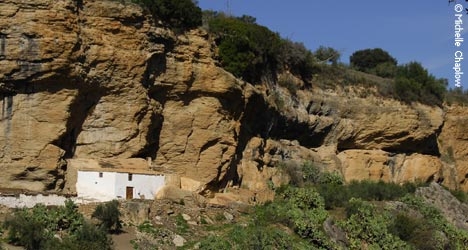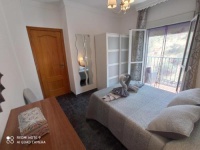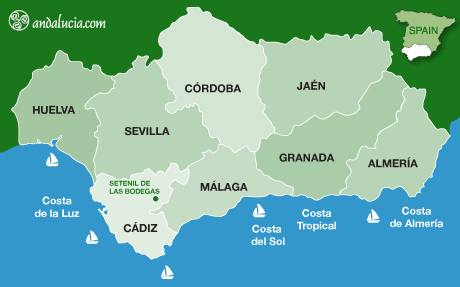
Tapa hopping along Calle Cuevas del Sol |
|
Setenil de las Bodegas
Named after its once flourishing wineries - bodegas - Setenil is probably unique among the pueblos blancos, white villages, of Andalucia. Where most pueblos blancos were built on protective bluffs and pinnacles, this town grew out of a network of caves in the cliffs above the rio Trejo north-west of Ronda. Its blinding white houses seem to emerge from the rocks, and some have rock roofs and even olive groves on their roofs.
There has been a human settlement here since at least the Arabic Almohad period in the twelfth century. Given the evidence of other nearby cave-dwelling societies, such as those at the Cueva de la Pileta west of Ronda, where habitation has been tracked back more than 25,000 years, it is possible that Setenil was occupied much much earlier. Most evidence of this would have been erased in its continued habitation. It was certainly occupied during the Roman invasion of the region in the first century AD.
Modern Setenil begins in 1484, relatively late in the Christian Reconquest, when the Christian armies expelled its Moorish, Granada-led Nasrid rulers. It took the Christians fifteen days to expel the Moors from the (nowadays ruined) castillo, castle, at the top of the town. The town name is believed to have been taken from the Roman Latin phrase "septem nihil", "seven times no", a phrase possibly linked to earlier invasions or skirmishes. The full moniker Setenil de las Bodegas dates from the 15th century, when its new, Christian, rulers developed an agricultural base of olives, almonds and vineyards. The first two still flourish on the hills and rooftops of Setenil, but its wine trade was wiped out by the phylloxera insect infestation of the 1860s, which effectively destroyed most European vine stocks.

Over the intervening centuries, Setenil also gained a reputation for its meat products, particularly chorizo, sausage, and cerdo, pork, from pigs bred in the surrounding hills. As well as meat, it is has a reputation for producing fine pasteles, pastries, and its bars and restaurants are among the best in the region. Its outlying farms also provide Ronda and other local towns with much of their fruit and veg.
The bars and restaurants in Setenil are very popular especially at weekend lunchtime when there is a lively atmosphere including motorbike . Try Bar Restaurante El Mirador in a small street just off the Plaza de Andalucía where numerous cafes serve on the terrace. Tapa hop along Calle Cuevas del Sol starting at Bar Francisco.
As well as the ruined Moorish castle - in theory, you can climb the vestigial tower, if you're careful - there is also the nearby church of the Encarnación, and the multi-tiered warren of steep, narrow streets in this compact, cliff-enclosed town (motorists beware). The tourism centre is also housed in a medieval building with a beautiful patterned Moorish wooden ceiling.
Hotels in and around Setenil
Book Hotels in and around Setenil
Around the village
If you are driving or hiking in the region of Setenil, there are two notable sites to visit quite nearby. The magnificent Roman ruins of first-century AD Acinipo, or Ronda la Vieja ('old Ronda'), are barely eight kilometres from here, and the views from above the ruined open-air theatre, complete with stage, backstage areas and semi-circular seating, are stunning.
On the road between Setenil and Ronda a small signpost on the eastern side of the road also points to the Bodega Las Monjas (a former nunnery), which produces the fine local red wine Principe Alfonso, named after the late Principe Alfonso de Hohenlohe, who founded the bodega - as well as the original jet-set hangout, the Marbella Club. There's a restaurant and the bodega sells its own wines.
Setenil's major festival is the festival of its patron saint, Sebastian, on 20 January. It celebrates Carnaval with every other village in February, prior to Lent. Its annual feria takes place in the first week of August.
The tourism office is on calle Villa in the upper town, telephone 956 13 42 61, open Tuesday-Sunday.
Setenil train station is about 5km east of the village on rolling countryside, There are only one or two trains a day in each direction for Algeciras, Ronda and Granada that stop at Setenil. More about Setenil train station and train service.

















